|
August 22, 2005
An Interview with Helga Smith: Servas Traveller,
Marathon Runner and Conqueror of Mount Kilimanjaro
I had a chance to meet Helga
recently at the Servas
Conference that I covered in Vancouver. Once you read Helga's
story you'll realize why she has been included in a recent book
called "Women Who Rock", featuring the stories of women
who have made outstanding contributions to business, sports or community
endeavours.
Originally from East Germany, Helga escaped to the West in 1963
and came to New York City a few years later. Without much help,
she raised three children, completed a university degree and successfully
established herself in the United States.
Helga has volunteered for a variety of non-profit organizations,
inspired others to get active by running marathon races and climbed
Mount Kilimanjaro to raise funds to help African women start their
own small businesses. Here is Helga's fascinating story:
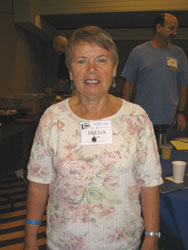
Helga Smith
1. Please tell us about your background. Where are you
from, where did you grow up?
I grew up in a country that does not exist anymore, East Germany.
Life was not much fun after WWII and it did not improve when the
communists took over in 1948. Since I lived close to West Berlin,
there was the constant reminder that life can be different. In those
of us, who were not willing to resign ourselves to the limitations
of the communist regime, it fostered a rebellion and the urge to
throw off the chains.
2. You left East Germany in 1963, 2 years after the Berlin
Wall was erected. Please tell us about your escape from East Germany.
When the Wall was built it became nearly impossible to leave the
country. If caught, the penalty for escaping from East Germany at
the time was 6 years in prison. But I was single with no binding
obligations, so I was willing to take a chance. I scouted out several
possibilities and finally got onto a train which passed locked thru
East Germany, stopped in East Berlin to let on foreigners and went
to West Berlin before being locked again for the second passage
thru East Germany to West Germany. I hid in the train and saw the
border police passing by inches away from me. Destiny must have
been on my side because the police did not detect me and I made
it to West Berlin.
The beginning in West Berlin was not easy since I had nothing, knew
nobody and the official help offered was barely enough to get one
outfit to go on a job search. Well, I did get a job, found an apartment
and basically was on my way.
3. A few years after you left East Germany you came to
the United States, to New York City. Please tell us about the first
few years in the United States.
Now that I was free to make my own decisions, the opportunity arose
to come to the United States. The fact that I did not speak any
English did not deter me. Indeed, it did make it a bit more difficult,
but challenges are there to make us grow.
I took a job as a domestic, learned English as quickly as I could,
made friends and a year later started working in an office. Soon
after, I married an American and we had three children during the
next five years. By that time my husband decided he did not want
a family after all and I was single again. Life became challenging
once more. To feed the children, I had to go on welfare for a while.
But I also attended school, and as soon as I had an associate degree
I started to work again. This time I took a job at a major financial
institution and stayed with them for more than 20 years in a variety
of positions. Along the way I acquired specialized computer skills
that allowed me to support my children thru college. My daughter
graduated from Harvard Law School and works for International Development.
My son attended Fordham University and lives in New York with his
Ecuadorian wife. Both of them are recognized and respected graffiti
artists, famous for murals in their neighborhood, the City and around
the world.
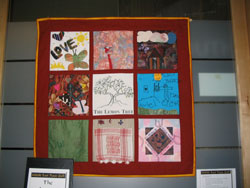
Israeli-Palestinian peace quilt
4. How and when did you hear about Servas? What countries
have you traveled to through Servas? How many people from what countries
have you hosted? In your opinion, what is special about traveling
through Servas?
My children were still teenagers when on a Sunday afternoon hike
I met a “little old lady traveling with a knapsack”*
who told me about Servas. It sounded interesting, but I did not
have the time or money to travel myself, so I decided to become
a host and let travelers come to me. Several years later, having
hosted dozens of people from many different countries, I became
really eager to travel myself.
If it had not been for Servas, I do not know whether I ever would
have had the courage to visit other countries on my own. But once
I started, it quickly became a fascination and my urge to travel
was dampened only by financial constraints and the brief annual
vacation employees receive in the US. During the 20 years I have
been a Servas member I have hosted hundreds of people and traveled
to more than 50 countries, visiting Servas people whenever possible.
There are 15000 Servas hosts in 135 countries, and even though it
may not always be feasible to stay with them or they may not be
available at the time, every visit is enriching in some way. Every
traveler coming into my home has something special about him or
her and I will always make an effort to have a meaningful encounter.
Vice versa, when I visit people in other countries, I like to find
out what their life is like, what are their concerns, what do we
have in common and how can we relate and help each other. In doing
so, I believe that we are fostering understanding and tolerance.
Often we are inspired and motivated to take actions in peace building
on the grassroots level. A network of Servas members worldwide helps
in that effort.
* (Sandy Cherry was listed in the host list with that quote. She
lived in California, and I met her years later at one of our national
Servas meetings in Boston.)
5. Please tell us about your 3 favorite or most memorable
hosting experiences with Servas.
One of my earliest encounters began in California where I met a
lovely young woman from Australia who was somewhat reluctant to
come to 1980s crime-ridden New York, or so it was perceived as in
those days. I encouraged her to visit me and of course she loved
it. Short after, she wrote to me that her parents also wanted to
come to New York and asked to find a place for them to stay. Naturally
I invited them into my home, even though they were not with Servas.
They were in the States for the first time and instead of doing
the usual sightseeing in New York, they visited a relative of a
friend of theirs in the hospital, because he had nobody else who
cared about him. I was very impressed by their humanitarian action
and selflessness.
During the first year as a host I was not sure of what precisely
hosting entailed. An elderly gentleman came to visit who had just
discovered Servas and thought it was a marvelous invention. He obviously
had his own agenda that had nothing to do with the Servas spirit.
After smoking up my apartment for three days, I asked him whether
he was going to stay with anyone else in New York. His answer was,
that he liked it here and that he felt just like at home. I did
not have the courage to tell him it was time to leave and he stayed
another three days.
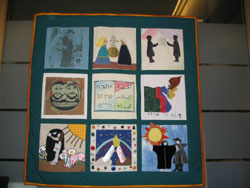
Israeli-Palestinian peace quilt
For the Millennium Forum in 2000, Servas hosts in New York were
asked to volunteer hosting UN delegates of NGOs who often do not
receive enough funding. I was privileged to host Muborak Sharipova
from Tajikistan who knew nothing about Servas. As a sociologist,
Muborak had lived the Servas spirit all her life, becoming a member
of Servas was just a logical extension of what she was doing all
along. We now have a close relationship and I am happy to help her
in more ways than one whenever she comes to New York.
6. Please tell us about your 3 most memorable or favorite
travel experiences with Servas.
While preparing for a trip to Japan, I had planned on visiting some
of the travelers who had stayed with me in New York and had kept
in touch. But I also wanted to visit places where I did not know
anyone and therefore picked from the Japanese host list. A family
was listed with two children that I thought would be interesting
to get to know, so I e-mailed them to ask for hospitality. The very
next day I received a reply: Don’t you remember? We stayed
with you in 1992! They had not been married then and needless to
say that I visited them in Kyoto and learned about the situation
of young Japanese professionals that may be very different today
from what the outside world thinks about the “typical”
Japanese family.
After hosting several travelers from South Africa and becoming
friends with them, I decided to visit that country. Days before
my departure I learned that my friend’s mother had passed
and she asked me to come to the customary Hindu memorial instead
of exploring the Garden Route at leisure. So I went to the SA airline
to change my ticket, explaining that a member of the family had
died. The airline immediately gave me the necessary ticket without
charge. When I told my friend how accommodating the airline had
been, she asked what would I have said if they had asked which member
of the family had died? I answered that she was like a sister to
me and I felt part of her family, which is exactly how I was treated
in her community.
Recently I attended the Vancouver bi-country Servas conference.
Having lived in New York most of my life and never having been north
of San Francisco in the States, I decided to start at that city
and travel over land to Vancouver, stopping by to visit Servas people
along the way. One of my destinations was a farm in Chehalis, Washington
State. Cheerfully Lorna taught me about Wwoofers (Willing Workers
On Organic Farms), healthy living, and picking blueberries for three
days. Even though she was born here and had little exposure to German
culture: while working, Lorna was singing German folksongs that
I could hardly remember, even though I had grown up in that country!
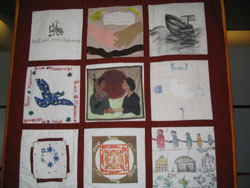
Israeli-Palestinian peace quilt
7. You are an avid Marathon runner. Please tell us when
you got started running and how that came about. What races have
you participated in and what do you like so much about running?
Until I started running I was never athletic, in fact I hated sports
all my life. At some point in my mid-fifties I realized that sitting
in front of the computer ten hours a day was not doing my body too
much good. So, when my daughter began training for her first marathon,
I started running short distances with her. Of course I also watched
her first race and it seemed like fun.
Then a somewhat bizarre incident happened: a friend of mine announced
that she was going to kill herself when she turned 60 because she
hated old people and did not want to become one of them. We were
unable to change her mind and in frustration and protest I decided
to do something more positive with my life: I was going to run a
marathon.
So I trained to be able to finish the first marathon and my daughter
ran together with me. I was 59 years old at that time. It was exhilarating
and like many runners I got hooked. So I trained properly for the
next marathon that I ran fast enough to qualify for Boston, the
oldest and most prestigious in the country. My daughter had also
qualified and we again ran together, two days before she left for
her 4-year assignment in Egypt.
To run a marathon requires training the body to push boundaries,
otherwise a person can get seriously hurt. So I would participate
in little races that are abundantly offered every weekend in New
York. Seeing my displayed race numbers at the office has inspired
numerous young people to become physically active as well and some
of them are now also marathon runners.
The New York Roadrunners Club organizes many races throughout the
year, most of them for one worthy cause or another. As long as I
am physically well, I participate in those that I enjoy and a cause
I support.
8. You also perform volunteer work in New York City and,
among other things, you dedicate your time to running with blind
people. Please tell us about that experience and other volunteer
projects you may have been involved in.
In New York there are abundant opportunities to volunteer. The organization
New York Cares alone has scores of projects every week. I have helped
with Habitat for Humanity, God’s Love We Deliver, company
sponsored projects, and so on. Since I am still traveling extensively,
at the moment I do not regularly volunteer for a specific cause
but pick assignments from the list and help out in soup kitchens,
parks maintenance, race activities, neighborhood associations, etc.
I also train with physically challenged, especially blind people,
who would not be able to enjoy this sport on their own. It gives
me great joy to help others doing something that I came to love
myself.
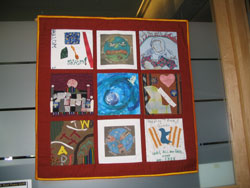
Israeli-Palestinian peace quilt
9. A few years ago you decided to climb Mount Kilimanjaro
to raise funds for a charity dedicated to small business loans.
Please tell us how you came up with the idea and how you selected
the cause. What was it like to climb Africa's highest mountain?
My daughter and I like to do things together, be it traveling, running,
hiking, etc. When one of us mentioned climbing Mt. Kilimanjaro,
the other immediately said that would be fun. So we decided to climb
the rooftop of Africa. While preparing for the event, it occurred
to me that I did not want to do this just for myself. There are
lots of races, bike rides and other events organized for some good
cause: why can’t I climb a mountain and let someone else benefit
from my efforts. So I choose the organization FINCA*
(Foundation for International Community Assistance) that gives small
loans primarily to woman in countries where it is particularly difficult
for women to start businesses. From my friends, colleagues and people
I met at various activities I raised $10,000 that were distributed
to the women in Tanzania which is where Mt. Kilimanjaro is located.
Having heard that it was possible for an average fit person to climb
the highest mountain in Africa, I felt ready for this challenge.
Mt. Kili is the only free-standing mountain in Africa and going
up consists basically of strenuous hiking in high altitude. The
mountain is almost 20,000 ft high and the distance from the entrance
gate to the top is nearly 60 miles. Most people take at least 6
days round trip, with the day of the ascent being the most difficult
part. It is important to go slowly enough to give the body a chance
to acclimate and to drink lots of water. Only about half the people
attempting to climb the mountain are successful, many underestimate
the difficulties and fail to pay attention to their body’s
ability to adjust.
With 120+ contributors on my fundraising list I had plenty of motivation
to go all the way and luckily my daughter was willing to share this
exciting event with me. We both managed to climb all the way to
the top – one of the most difficult things we had done so
far but also one of the most exhilarating. Every successful climber
was thrilled about the experience and the satisfaction of having
accomplished it showed in their faces.
10. You have also joined an activist group called the "Non-Violent
Peaceforce". Please tell us what they do and why you are considering
working with them. What else is in your plans for the next few years?
The Non-Violent
Peaceforce trains people to put themselves “in harm’s
way”, that is, people are deployed into places where an outside
group can act as a buffer to diffuse a potentially violent situation.
NP works with the United Nations on peaceful solutions and conflict
prevention in hostile environments. I do not know whether I will
be chosen as a team member, but it seems a worthy cause to support
and I am willing to participate in their actions. NP also works
as election overseer and other less potentially dangerous events.
Plans for the future? Aside from more traveling, involvement with
Servas and other NGOs, nothing in particular comes to mind at the
moment. But that may change any day…
Thank you, Helga, for your sharing your stories of courage. You
obviously love challenges and we wish you the best of luck for whatever
you choose to get involved in.
Related Articles:
Presenting: Pablo Chufeni -
Servas member, champion of youth causes for Servas
Presenting: Mary Jane Mikuriya -
Servas traveller, volunteer for peace and social justice
Presenting: Robert & Bette Allekotte
- Servas members & family travellers
My interview with Patrice Samara
from US Servas
Preview: Robert
& Bette Allekotte - Servas members & family travellers
Preview: Gilbert
Sherr - Servas traveller & cultural researcher
Preview: Mary
Jane Mikuriya -Servas traveller, volunteer for peace & social
justice
Preview: Helga
Smith - Servas member, Marathon runner, conqueror of Mt. Kilimanjaro
Preview: Pablo
Chufeni - Servas member, Champion of youth causes in Argentina
Coverage of the first Canada-US
Servas Conference in Vancouver
Interview with Patrice Samara from
the US Office of Servas
|